There are over 60 private/club/DOC huts in the Orongorongo valley. Our mission was to see how many we could find from out base at Paua hut.
I had worried about the weather for the weekend as the forecast had predicted some rain. However, the Friday was warm and sunny and we had a pleasant tramp over the Orongorongo track in the evening. There was a lovely orange glow from the sunset on some of the surrounding hills that we could see at times.
Julie had never tramped in the dark before so this track is an ideal place to start as it’s well graded and not too rough. We heard a number of bird calls and one that Michaela said was a kiwi. Both Julie and I were a bit skeptical about this but Michaela was later proved to be correct (keep reading).
We bagged our first hut for the weekend, Macs hut, towards the end of the Orongorongo track. This hut is now owned by DOC but is locked and not available for use.
We reached the Orongorongo river and headed downstream. Neither Julie or Michaela had crossed rivers on tramps before so we used the mutual support method on our four or five crossings on our way to Paua hut. As we travelled downstream we could see lights coming from Raukawa Lodge and Boar Inn.
Paua hut was the second hut to be bagged. This hut belongs to our club and is an excellent resource and base to have in the Orongorongo valley. The hut was very spic and span and after some supper we went to bed. It was windy overnight but luckily there was no rain.
On Saturday we started hut bagging in earnest. Bambazoola is about two minutes from Paua hut so was easy to knock off. From the oily smell coming from a shed and peering through a hole in a wall it was possible to smell and see a diesel generator that provides electricity for the hut.
The next hut, Riverside, is on the other side of Greens stream from Paua hut. There is an interesting mural showing native birds along with introduced animals/pests on one wall of this hut. It was not possible to see inside as all of the curtains were drawn.

From Riverside we popped up to the Landcare Research station. This is a complex of four or five buildings including an accommodation/living block, laboratory, and various sheds. In the past this station was a base for people undertaking research on the bush and impact of pests such as possums on the bush. This research has come to an end and these days the station is only used now and then for trapping related activities.
Our next stop was Boar Inn. This used to be a private hut but is now a bookable DOC hut. People had stayed there on the Friday but there was no-one there when we visited.
From Boar Inn it was a short walk to Delta Lodge and Cookies. These are both A-frame huts and are in sunny spots on a bluff looking north up the Orongorongo river.
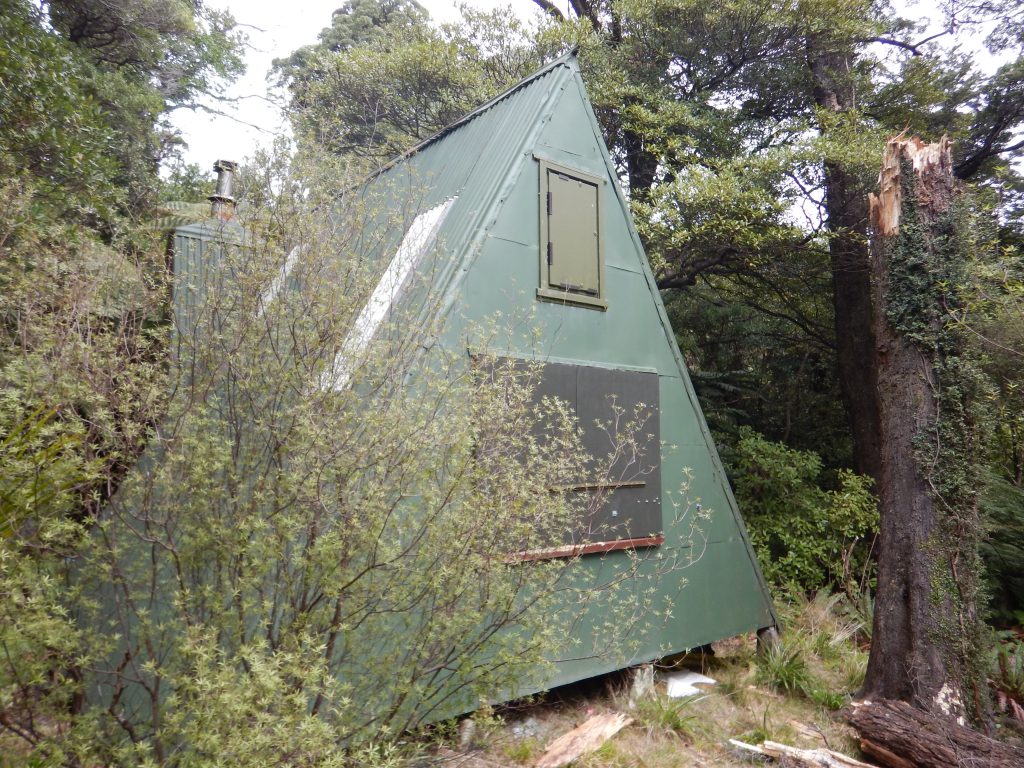
We had a look for Wai Whare and Journeys End but could not see them so our next stop-off was Raukawa Lodge. This is also a DOC bookable hut and was built in the 1970s by the Wellington Regional Water Board. There was smoke coming from the chimney but no-one was at home. We had some morning tea on the veranda and then continued with our mission.
Waeranga hut was next, a short walk away. This is the Tararua Tramping Club hut and is in good condition and looked clean and tidy inside. This hut has a large wooden deck which would be a sun-trap on a sunny day. Waerenga and Paua huts are the only tramping club huts in the Orongorongo valley.
Waerenga is located just off Browns stream and we spent the next while exploring this stream and bagged Kiwi, Kia Ora, Tahora and Taihoa huts in quick succession.
There was smoke coming from the chimney of Kiwi hut but no-one was home.
Tahora is a large hut set in a grassy clearing. There is a plaque in the clearing to previous hut owner Owen Mitchinson. Mitchinson died from a heart attack at the hut in 1989.
Taihoa is a well constructed hut with top quality stonework, coloured inserts in the windows, a fish pond and a small A-frame long-drop. In the comfortable looking interior there is a mural of people hunting and gathering.
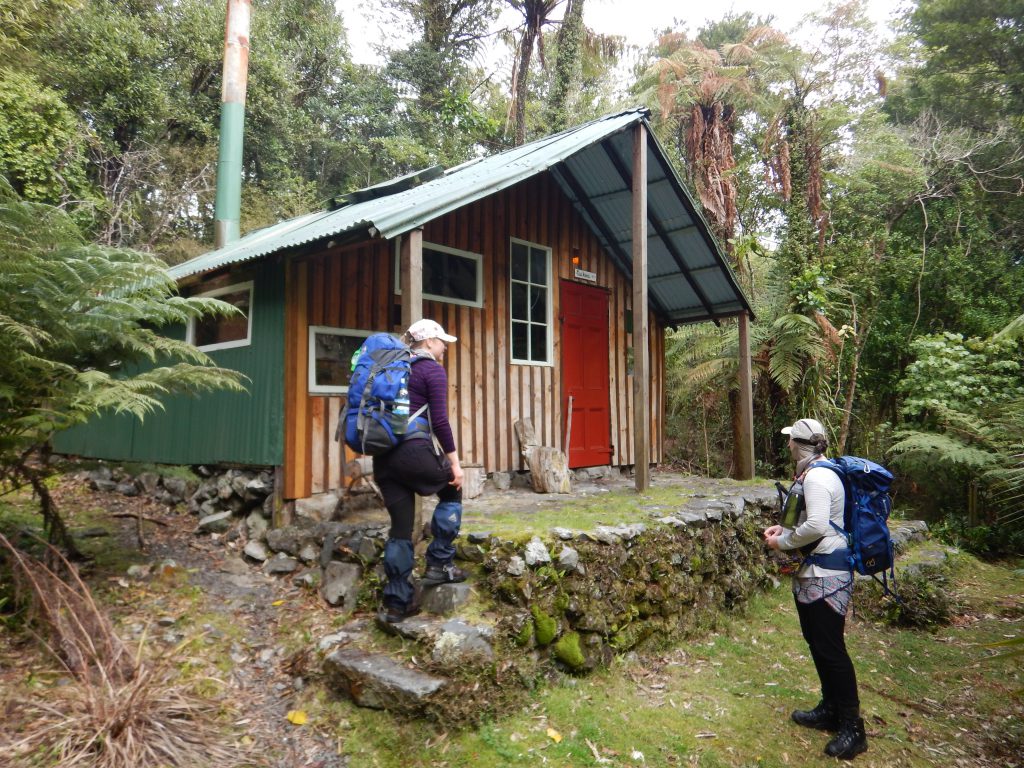
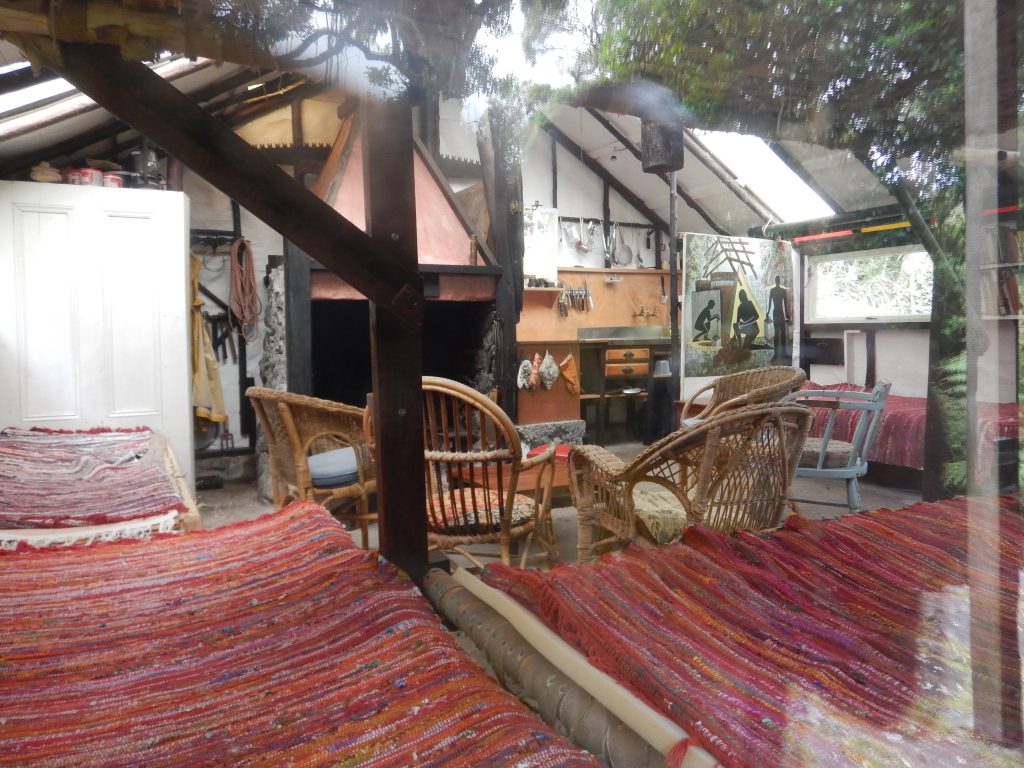
Near Taihoa we came across two concrete pads/bases of previous huts that have been burnt down or otherwise destroyed. The bases were in good condition but are covered with moss and some plants so the huts must have been gone for many years.
Waikapai was next to be bagged. This hut also has very sturdy stonework steps and fireplace. There was a young man there with his dogs. He had spent the Friday night there with friends but they had left him to tidy up. This hut is located on a pleasant grassy lawn.
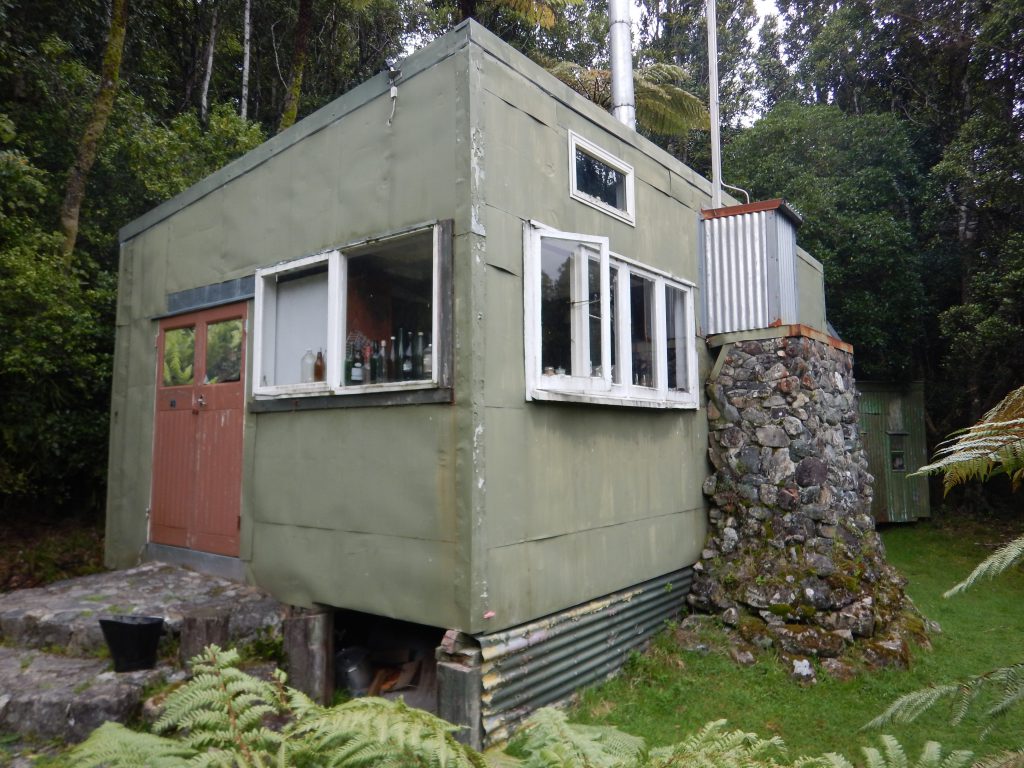
Our next huts were Johnstone’s, Jans and Mahoe.
Johnstone’s hut has in spacious porch area with sink and there is also a memorial plaque to Kenneth Johnstone who spent a great deal of time in this hut.
Jans is also a previous private hut that is now a bookable DOC hut. This hut was in very good condition and clean and tidy and looked bright inside.
Mahoe was completely closed up so we couldn’t see inside but the hut was in good condition. We had a late lunch on a bluff near Mahoe hut overlooking the Orongorongo valley. It had been windy all day but not cold and the predicted rain had not arrived. It was 2pm by this time and we gave ourselves until 4pm as our turn-around time – so we still had some time to bag a few more huts.
Xanadu was next. This is a large hut with a large veranda and big glassy windows. Xanadu is visible from the Big Bend track and is located on a point on the true left of the river. Exhaust pipes and an oily smell from the hut basement indicated that Xanadu also has a generator and inside we could see lights, a fridge, oven and microwave oven. This hut is solidly built with sturdy stonework in places and doors that could have come from a castle.
We crossed the river near Xanadu and visited Fern Lodge and Boulder huts. These huts are south facing so are noticeable cooler and damper than the north facing huts. We had a look for the Big Bend track near Boulder hut but emerged behind Turere Lodge (which was our next stop-off anyway). This is a large 32 bed DOC hut. There were people staying there and from the looks they gave us it was like they had never seen humans before.
We pushed on along the Big Bend track and stopped by at Amber Inn and then Manuka. While I was telling Julie and Michaela about a wet morning tea under the Manuka hut porch on a previous trip we saw club member Cindy and a friend walking past. They were returning from a day trip to a very windy South Saddle and were hurrying back to the carpark so they could get out before the gates closed at 6pm.
Our most northern hut of the weekend was Haurangi hut. This is a modern DOC hut. These DOC huts are generally very popular and at times are booked well in advance. However, there was no-one there so wenhad some sugary snacks (and Julie had one of her Pics peanut butter shots) and headed back downstream to Paua hut.
We saw Rovers Return and Shalimar from the riverbank but were feeling a bit too tired so didn’t visit these two (they will be on the list for next time).
Our last hut of the day was Black Whare which is roughly opposite Boar Inn. We got back to Paua hut at about 5.15pm after being on the go for over 8 hours. We enjoyed relaxing, eating chippies and popcorn and then dinner. We did a bit cleaning in the hut and swept out the toilet shelter and were in sleeping bags by about 8.30.
We’d had a successful day and had bagged 24 huts.
It was very windy overnight but Paua hut was well built so didn’t shake or creak too much. It sounded like rain at times but it was dry in the morning. We lost an hour sleep due to changing to daylight saving time but we were still away at 9am to knock off two more huts.
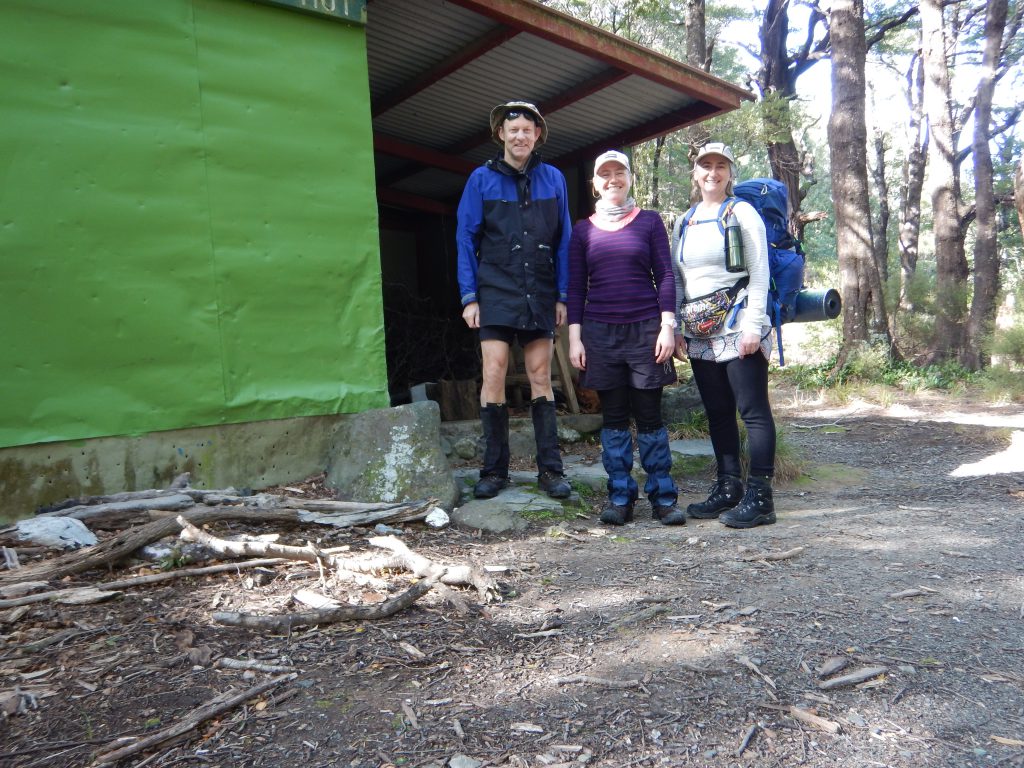
Zacs and Nikau are located about 1km downstream of Paua hut and are accessible off the 4WD track the runs down the true left of the valley.
We could not see into Zacs hut but there is a long-drop with an expansive view upriver. We had a bit of trouble finding Nikau hut but did manage to find it. Nikau has a landscaped area around it with bench seats, an outdoor shower, tree-house, swing and another long-drop with fine views.

We walked back to Paua hut and headed back to Turere bridge and Orongorongo track. Our discoveries were not over. We saw the plaque by Turere bridge to people who have died in the valley and we also saw the memorial to Don Dement, ex-WTMC member, who drowned in the valley in 1951.
Towards the end/start of the Orongorongo track we stopped off at the DOC information stands which have bird sound gadgets. We listened to these gadgets and one of these confirmed that the bird call we heard on Friday evening was a kiwi – Michaela was correct all-along.
We had a fun weekend of exploring the Orongorongo valley with pretty good weather. We had the use of the excellent base of Paua hut. There are still about 30 huts to find so I’ll have to organize another hut bagging mission in future.
Thanks to Julie and Michaela for coming along and for being such good company.
Reference : Cochran, C., Maclean, C., Sheppard, A. (2015), Built heritage of the Orongoronogo valley. The Orongorongo Club Inc : Wellington.
Photo credits Tony S

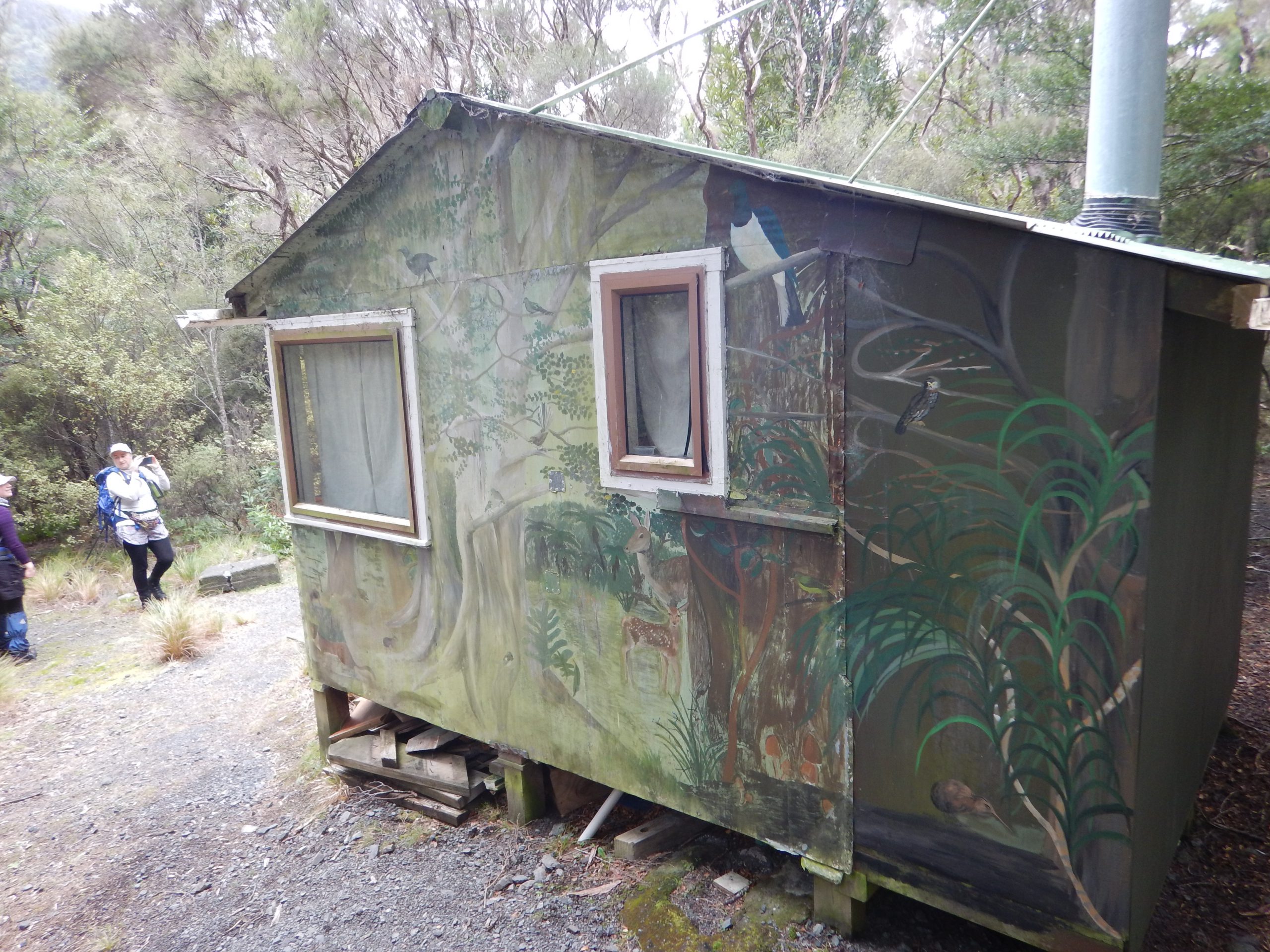
Hi Megan. Yes it was a fun tramp. It was like a treasure hunt finding the huts. Many of the huts have their name on the door. The book really helped us find some of the more hidden huts. Look out for Hut Bagging part II in future!
Hi Megan. It was a fun trip. Michaela said it was like a treasure hunt. Lots of the huts have their names on their door. The book was very helpful to us in finding some of the more hidden huts. Look out for Hut Bagging part II in future!
Hi Megan – yes it was a fun trip. Michaela described it as like being a treasure hunt. Lots of the huts have their names on the door. The book was useful to us in finding the more hidden huts. Look out for Hut Bagging part II in future! (I’ll let you know as well).
Sounds like a great trip Tony! Just curious if you found the names of all the huts from the book, Built heritage of the Orongoronogo valley? And let me know when you plan the next hut bagging trip!